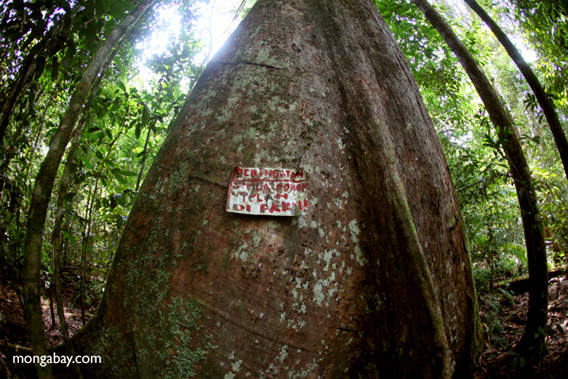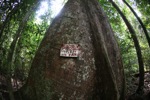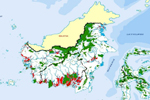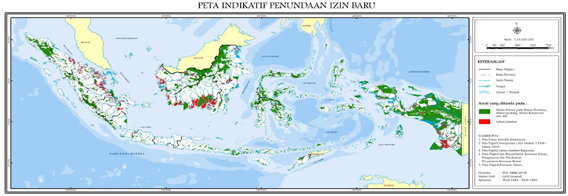Indonesia’s moratorium on new forest concessions alone “does not significantly contribute” to its goal of reducing greenhouse gas emissions 26 percent from a projected 2020 baseline, concludes a new analysis by the World Resources Institute (WRI). However the study says the moratorium does support the target in the long-term by creating a window for enacting governance reform needed to stop destructive business-as-usual approaches to forest management.
“Although there are 43.3 million hectares of primary forests and peat lands and significant carbon stocks within the boundaries of the indicative moratorium map, the questionable status of secondary forests, the exemption of existing concessions, and the limited enforcement of the moratorium boundaries may result in gains being negated by other land-use emissions,” states the analysis, which was authored by WRI’s Kemen Austin, Stuart Sheppard, and Fred Stolle. “Nonetheless, long-term positive impacts can still be achieved if significant governance reforms are accomplished during the moratorium period.”
Indonesia’s moratorium on new plantations and logging concessions in primary forests areas and peatlands was implemented in May 2011 under its climate action plan, which aims to substantially reduce carbon emissions from deforestation and degradation of peatlands and forests. But the moratorium was substantially weaker than expected, with many exemptions, including a free pass to convert secondary forests and loopholes for mining and energy development. Environmentalists immediately expressed disappointment with the moratorium and raised a number of concerns, some of which are now seconded by the working paper from WRI.
Indonesia’s moratorium on new forest concessions: key findings and next steps reports that some “3.5 million ha of primary and peat forests inside the moratorium boundaries are not protected”. Conversion of this land could release 14.6 billion tons of carbon dioxide. It notes that since much of the area covered by the moratorium was already legally conserved, the government’s plan only increases the forest and peatland acreage under protected by 11.3 million ha — 26 percent of the total moratorium area. Another 15.6 million ha of the moratorium area includes secondary forest, which isn’t explicitly protected, potentially putting it in limbo. Finally the report cites research showing that the moratorium isn’t being respected — more than 100 new clearings were detected in off-limits areas during the initiative’s first three months.
Still the working paper finds reason for hope. It says that despite its weaknesses, the moratorium “pauses” some business-as-usual patterns that have destroyed vast tracts of Indonesian forest over the past half-century. Opportunities for improvement during that window include fostering transparency in land use; governance reform, including processes for allocating forestry permits; strengthening monitoring and law enforcement; boosting coordination between ministries; establishing performance-based metrics; and encouraging a shift toward low carbon development.
“The moratorium creates incentives for increased productivity and the use of low carbon degraded land, rather than forests or peat lands, as a viable alternative for agricultural and forest plantation expansion,” said WRI. “Any agricultural expansion should be confined to those deforested, non-peat lands and implemented in a manner that fully respects the rights of indigenous peoples and local communities.”

Sign warning that a rainforest tree has been spiked to discourage illegal logging in Indonesian Borneo. Photo by: Rhett A. Butler.
Already there are signs of change. Last year, Kuntoro Mangkusubroto, head of the Indonesian President’s REDD+ Task Force, said the government would immediately work to
implement a decade-old law that requires recognition of adat or customary rights. The effort will include developing a land tenure map so government agencies can better understand how communities are using land and delineating the legal status of the Indonesia’s forest area, which could help keep more forest standings. At the same time, PT SMART announced it will no longer convert land with more than 35 tons of carbon for plantations, becoming the first palm oil major in Indonesia to agree to such restrictions. Finally, WRI and local partners are developing a near-real-time forest monitoring tool that uses satellite imagery to detect deforestation, creating what could become a powerful tool for law enforcement, provided there is sufficient political will to crack down on business-as-usual.
But for all the positives, the question of political will remains critical. To date, the push to break from the business-as-usual course in the forestry sector has been supported by Indonesian President Susilo Bambang Yudhoyono, who has said he wants his legacy to his grandchildren to be Indonesia’s forests. Once SBY leaves office, it’s unknown whether his successor will share his zeal.
Related articles
Indonesia’s moratorium undermines community forestry in favor of industrial interests

(06/21/2011) Indonesia’s moratorium on new concessions in primary forest areas and peatlands “completely ignores” the existence of community forestry management licenses, jeopardizing efforts to improve the sustainability of Indonesia’s forest sector and ensure benefits from forest use reach local people, say environmentalists. According to Greenomics-Indonesia, a Jakarta-based NGO, community and village forestry licenses are not among the many exemptions spelled under the presidential instruction that defines the moratorium. The instruction, issued last month, grants exemptions for industrial developers and allows business-as-usual in secondary forest areas by the pulp and paper, mining and palm oil industries.
Lack of clarity complicates Indonesia’s logging moratorium

(05/27/2011) Lack of clarity makes it difficult to assess whether Indonesia’s moratorium on new logging concessions in primary forest areas and peatlands will actually reduce greenhouse gas emissions from deforestation, according to a new comprehensive assessment of the instruction issued last week by Indonesian President Susilo Bambang Yudhoyono. The analysis, conducted by Philip Wells and Gary Paoli of Indonesia-based Daemeter Consulting, concludes that while the moratorium is “potentially a powerful instrument” for achieving the Indonesian president’s goals of 7 percent annual growth and a 26 percent reduction in greenhouse gas emissions from a projected 2020 baseline, the language of the moratorium leaves significant areas open for interpretation, potentially offering loopholes for developers.
Indonesia’s moratorium disappoints environmentalists

(05/20/2011) The moratorium on permits for new concessions in primary rainforests and peatlands will have a limited impact in reducing deforestation in Indonesia, say environmentalists who have reviewed the instruction released today by Indonesian President Susilo Bambang Yudhoyono. The moratorium, which took effect January 1, 2011, but had yet to be defined until today’s presidential decree, aims to slow Indonesia’s deforestation rate, which is among the highest in the world. Indonesia agreed to establish the moratorium as part of its reducing emissions from deforestation and degradation (REDD) agreement with Norway. Under the pact, Norway will provide up to a billion dollars in funds contingent on Indonesia’s success in curtailing destruction of carbon-dense forests and peatlands.
Is Indonesia losing its most valuable assets?

(05/16/2011) Deep in the rainforests of Malaysian Borneo in the late 1980s, researchers made an incredible discovery: the bark of a species of peat swamp tree yielded an extract with potent anti-HIV activity. An anti-HIV drug made from the compound is now nearing clinical trials. It could be worth hundreds of millions of dollars a year and help improve the lives of millions of people. This story is significant for Indonesia because its forests house a similar species. In fact, Indonesia’s forests probably contain many other potentially valuable species, although our understanding of these is poor. Given Indonesia’s biological richness — Indonesia has the highest number of plant and animal species of any country on the planet — shouldn’t policymakers and businesses be giving priority to protecting and understanding rainforests, peatlands, mountains, coral reefs, and mangrove ecosystems, rather than destroying them for commodities?
